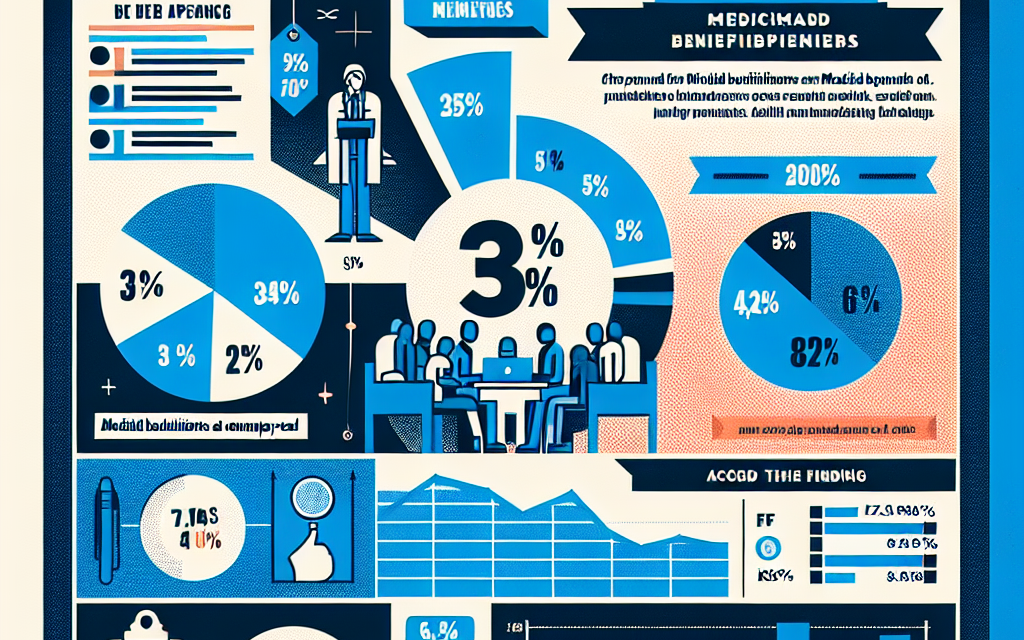Majority of Medicaid Beneficiaries Are Employed, According to KFF
The perception that Medicaid primarily serves the unemployed or those unable to work is a common misconception. However, recent data from the Kaiser Family Foundation (KFF) reveals that a significant portion of Medicaid beneficiaries are, in fact, employed. This article delves into the complexities surrounding Medicaid, employment, and the socio-economic factors that contribute to this phenomenon. We will explore the demographics of Medicaid beneficiaries, the relationship between employment and Medicaid, the challenges faced by working beneficiaries, and the implications for policy and healthcare access.
Understanding Medicaid: A Brief Overview
Medicaid is a state and federal program designed to provide health coverage to low-income individuals and families. Established in 1965, it has evolved to cover a diverse population, including children, pregnant women, elderly individuals, and people with disabilities. The program is funded jointly by the federal government and states, with each state having the flexibility to design its own Medicaid program within federal guidelines.
As of 2021, Medicaid covered over 80 million individuals in the United States, making it one of the largest health insurance programs in the country. The eligibility criteria for Medicaid vary by state, but generally, individuals must meet income requirements, which are often set at a percentage of the federal poverty level (FPL). In many states, the expansion of Medicaid under the Affordable Care Act (ACA) has further increased enrollment among low-income working adults.
Demographics of Employed Medicaid Beneficiaries
According to KFF, a significant percentage of Medicaid beneficiaries are employed. In fact, approximately 60% of non-elderly adult Medicaid beneficiaries are working. This statistic challenges the stereotype that Medicaid is primarily for those who are unemployed or unable to work. Understanding the demographics of these employed beneficiaries is crucial for grasping the broader implications of Medicaid in the workforce.
- Age and Gender: The majority of employed Medicaid beneficiaries are between the ages of 18 and 64. Women make up a larger proportion of this group, often due to their roles as caregivers and their participation in low-wage jobs.
- Race and Ethnicity: Medicaid beneficiaries come from diverse racial and ethnic backgrounds. A significant number of employed beneficiaries are people of color, highlighting disparities in income and access to healthcare.
- Geographic Distribution: Employment among Medicaid beneficiaries varies by state and region. States that expanded Medicaid under the ACA tend to have higher rates of employed beneficiaries compared to those that did not.
- Education Level: Many employed Medicaid beneficiaries have a high school diploma or some college education, but they often work in low-wage jobs that do not provide health insurance.
- Family Structure: Many employed Medicaid beneficiaries are parents, often balancing work with childcare responsibilities, which can impact their employment status and health coverage.
These demographics illustrate that employed Medicaid beneficiaries are a diverse group facing unique challenges. Understanding their backgrounds helps to inform policies aimed at improving healthcare access and employment opportunities.
The Relationship Between Employment and Medicaid
The relationship between employment and Medicaid is complex. While many employed individuals qualify for Medicaid due to low income, their employment status does not always guarantee access to employer-sponsored health insurance. Several factors contribute to this dynamic:
- Low-Wage Jobs: Many employed Medicaid beneficiaries work in low-wage jobs that do not offer health insurance benefits. Industries such as retail, hospitality, and food service often lack comprehensive health coverage for employees.
- Part-Time Employment: Part-time workers may not qualify for employer-sponsored health insurance, leaving them reliant on Medicaid for coverage. This is particularly common among workers in sectors with fluctuating hours.
- Job Insecurity: The gig economy and temporary employment have increased job insecurity, making it difficult for individuals to maintain consistent health coverage through their employers.
- Income Fluctuations: Many employed individuals experience fluctuations in income that can affect their eligibility for Medicaid. A small increase in hours or wages can disqualify them from receiving benefits.
- Health Needs: Employed individuals may have health needs that require more comprehensive coverage than what is offered through their jobs, prompting them to seek Medicaid as a supplemental option.
This relationship underscores the importance of understanding how employment status interacts with health insurance coverage. It also highlights the need for policies that address the gaps in coverage for low-wage workers.
Challenges Faced by Employed Medicaid Beneficiaries
Despite being employed, many Medicaid beneficiaries face significant challenges that impact their health and well-being. These challenges can be categorized into several key areas:
- Access to Care: Employed Medicaid beneficiaries often struggle to access healthcare services due to limited availability of providers who accept Medicaid. This can lead to delays in care and poorer health outcomes.
- Transportation Issues: Many employed individuals lack reliable transportation, making it difficult to attend medical appointments, especially if they work non-traditional hours.
- Workplace Flexibility: The demands of their jobs may not allow for time off to seek medical care, leading to a cycle of neglecting health needs.
- Stigma and Misunderstanding: Employed Medicaid beneficiaries may face stigma from peers or employers, leading to feelings of shame or reluctance to seek help.
- Financial Strain: Even with Medicaid coverage, out-of-pocket costs for medications and services can be burdensome for low-wage workers, impacting their financial stability.
These challenges highlight the need for targeted interventions to support employed Medicaid beneficiaries. Addressing these issues can lead to improved health outcomes and greater workforce participation.
Policy Implications and Recommendations
The findings from KFF regarding employed Medicaid beneficiaries have significant implications for policymakers. Understanding the needs of this population can inform strategies to improve healthcare access and employment opportunities. Some key recommendations include:
- Expanding Medicaid Coverage: States that have not expanded Medicaid should consider doing so to provide coverage for more low-income working adults.
- Enhancing Employer-Sponsored Insurance: Policies that incentivize employers to offer health insurance to low-wage workers can help bridge the coverage gap.
- Improving Access to Care: Increasing the number of providers who accept Medicaid and expanding telehealth services can improve access for employed beneficiaries.
- Transportation Support: Programs that provide transportation assistance for medical appointments can help mitigate access issues.
- Workplace Policies: Encouraging flexible workplace policies that allow employees to take time off for health needs can improve overall health outcomes.
By implementing these recommendations, policymakers can create a more equitable healthcare system that supports employed Medicaid beneficiaries and addresses the barriers they face.
Conclusion: A Call for Awareness and Action
The data from KFF revealing that a majority of Medicaid beneficiaries are employed challenges long-held stereotypes about the program. It underscores the importance of recognizing the diverse needs of this population and the barriers they face in accessing healthcare. As we move forward, it is crucial for policymakers, employers, and healthcare providers to work collaboratively to address these challenges and improve health outcomes for employed Medicaid beneficiaries.
In summary, understanding the demographics, employment dynamics, challenges, and policy implications surrounding employed Medicaid beneficiaries is essential for creating a more inclusive and effective healthcare system. By acknowledging the realities of this population, we can foster a more equitable society where all individuals have access to the care they need to thrive.





